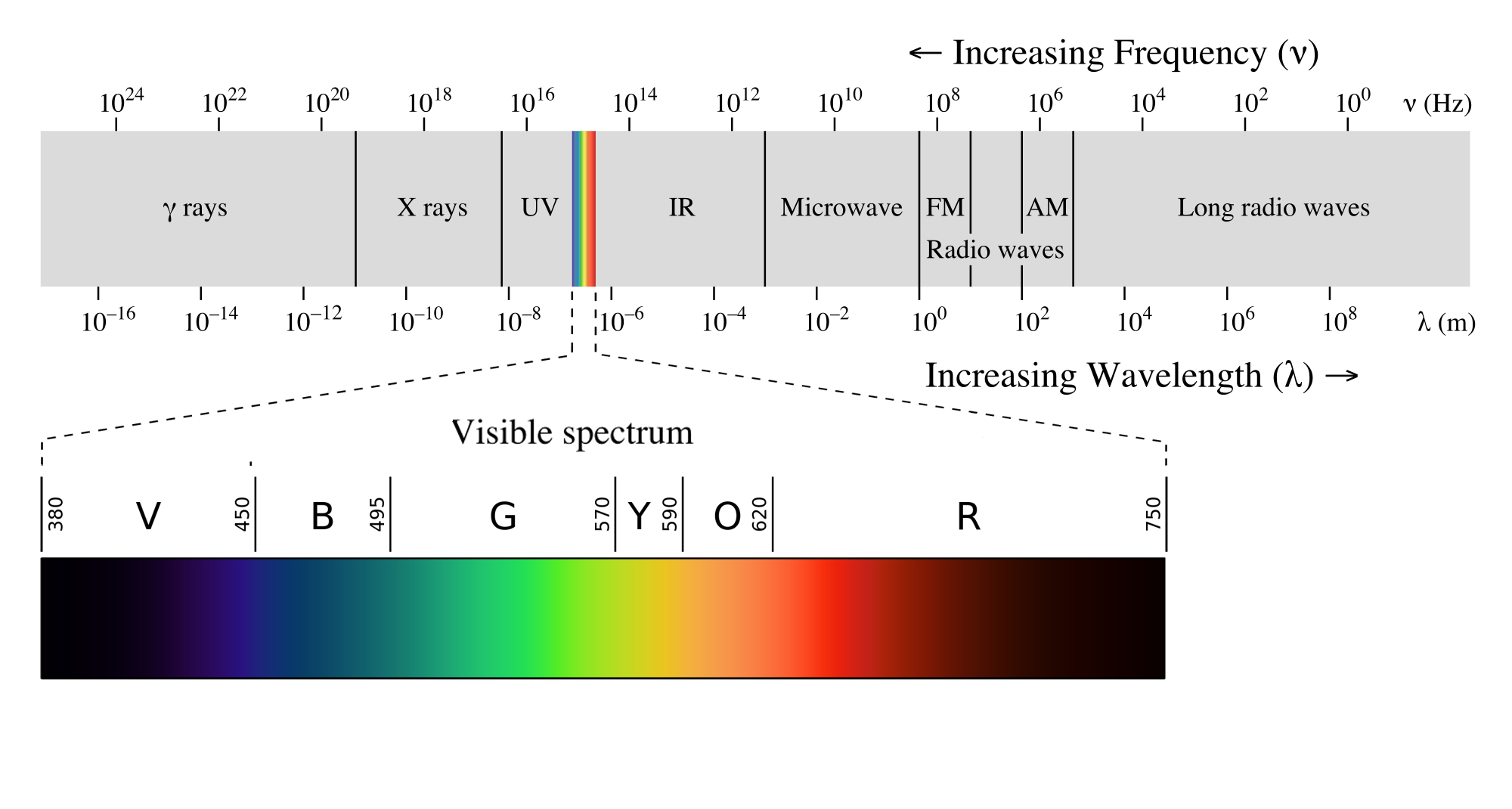The physical properties of light are important for our understanding of color. Here we introduce how physicists think about light and the properties that define it. Most importantly, we will see how these properties relate to the color we see.
As you are reading this lesson, you are most likely surrounded by a variety of lights. Light emits from your computer screen and from the lamps in your room. Light enters through your windows or open door. Light even comes from your refrigerator when you get a snack! You interact with light in various ways throughout your day; and while most of this light is white, some is more colorful. Some examples are street lights, the light creating the colors on this page, and the light coming from a hot stove top. In this lesson, we will explore the properties of light and how it creates the colors we see.

White Light is a Mixture of Colors
Let’s begin by talking about white light. When light travels from the Sun, or most other sources of illumination, we perceive it as lacking a hue. We call this white light. In reality, white light is a mixture of many colors of light. This mixture can be seen by using a prism to split apart the different colors that make up the mixture.

Do you see how white light goes into the prism and the entire spectrum of colors emerges from the other side?
What is happening here? We are witnessing the process of dispersion when we see white light spread out into its different colors. Dispersion is a property of waves, and causes waves to be separated by their wavelengths. By studying the dispersion of light, and many other properties we won’t discuss here, we have learned that light is an electromagnetic wave. We threw a lot of new words at you just now. Let us start by describing what a wave is. We will break this idea down and study the general properties of waves and then look more at electromagnetic waves.
Light is an Electromagnetic Wave
Waves are traveling motion
A wave is a repetitive motion traveling through a medium. Some examples are shown in the table below.
| Type of Wave | Medium |
|---|---|
| Ocean wave | Water |
| Sound wave | Air |
| Light | ? |
Interestingly, a wave can travel long distances without needing the medium itself to travel that full distance. For instance, the crests of an ocean wave can be ridden all the way to the shore, but very little of the water actually moves closer to shore. The water mainly moves up and down at the same location. A great example of this is when a crowd of people performs “The Wave” while at a sports event. If everyone works together, the wave can propagate throughout the entire stadium, but each individual remains in their original location, simply moving up and down when the wave passes through them.
Properties of Waves
Scientists characterize waves using two properties called wavelength and speed. Wavelength describes the length of one repetition of the wave, or in other words, the distance between the peaks. You can use the interactive drawing below to see how the wavelength affects the appearance of the wave. In this drawing, waves beyond the visible range are displayed as black. (We will discuss the visible range more below!)
The speed of a wave describes how fast the wave crests moves forward. Sound and light are both waves but they have very different speeds. During a thunderstorm, you see lightning flash before you hear the boom of thunder even though both waves started in the same location. This is because the speed of a sound wave is 343 m/s (meters per second), while the speed of light is 299,792,458 m/s. For comparison, a highway speed limit of 60 miles per hour is about 27 m/s.
You may have noticed that, as you changed the wavelength with the slider above, the color also changed. This is because the wavelength of light controls its color. The sensors in our eyes react differently to different wavelengths, which leads to perceiving different sensations of color. Red light has a long wavelength and purple light has a shorter wavelength. Using the interactive drawing above, pick a red color and a purple color and notice how different their wavelengths are.
Light with a wavelength between 380 and 700 nanometers is called the visible spectrum and it is the only type of electromagnetic waves our eyes can detect.[✱]For comparison, a human hair is about 50,000 nanometers in diameter. But light exists outside of that range as well. The whole spectrum of light is called the Electromagnetic Spectrum. Looking at the figure below that summarizes this spectrum, you can see that some wavelengths of light correspond to microwaves that help to heat your food or deliver your WiFi signal. Similarly, another part of the spectrum corresponds to longer radio waves that allow you to listen to your favorite music on a radio receiver. We can’t see microwaves or radio waves like we can see visible light but we interact with these waves in other ways.

Electromagnetic Waves
Finally, if visible light is part of the Electromagnetic Spectrum, what exactly is an electromagnetic wave? Electromagnetic waves are waves, like sound waves or ocean waves. Instead of traveling vibrations in the air or water, they are vibrations of … it is complicated. Their motion involves both an electric field and a magnetic field. (In this context, a field is similar to a map that describes how an electric charge or a magnet would be affected if placed at any location.) Studying the inner workings of electromagnetic waves has led to some of the greatest discoveries in Physics: general relativity and quantum mechanics. Instead of retracing the steps of physicists over two hundred years to discover the inner workings of electromagnetic waves, we have focused on describing light, based on what we can measure about it, such as its wavelength.
If you are interested in learning more topic related to electromagnetic waves, go to the lessons on Electricity and Magnetism.
Light Waves and Color
Let’s wrap up by discussing how light waves interact with colored materials, and what it even means for a material to have a color.
A neat property of light is that it travels differently through different materials. One example is that light travels at a different speed in the air and in water. Each time light travels from one material to another, it can be reflected, absorbed, or transmitted. When light is reflected, it bounces off the interface where the materials meet and travels in the other direction. When it’s absorbed, the light doesn’t travel in the new material but is absorbed by the particles in the material instead. This can result in heat. This is why your black shirt gets hot in the sun; it absorbs a lot of light. Finally, light can be transmitted, which means the light keeps traveling in the new material, although it may have a different speed or direction. Importantly, different wavelengths (i.e. different colors) of light can interact differently with a given material.
When we look at an object, we see its color. But how does this happen? When the light in the room hits the object, some of the light is absorbed by the color pigments in the object, while the rest is reflected. If an object absorbs all colors of light except for blue, the blue light wave will reflect off of the object and travel until it hits another object. When it hits our eyes, we see the blue light and describe the object as blue. In order to see any object, some of the light must be reflected to your eye. The wavelengths of light that are reflected control what color we see.
To learn more about colors and how the different wavelengths combine to make the colors we see, go to the lesson on Color Theory. To learn more about how our eyes perceive color, go to the Biology of Sight adventure.
